By Sam Radding
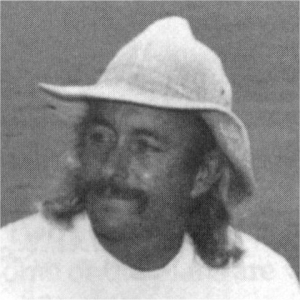 Time, like the river in front of our camp, takes some interesting twists. Some years back, I sat on a boulder by a small creek with a fishing rod in one hand and a gold pan in the other. I can still remember wondering whether I looked as foolish as I felt. Was I actually going to put some dirt into the pan and try my hand at gold mining? — Or was I just going to go fishing?
Time, like the river in front of our camp, takes some interesting twists. Some years back, I sat on a boulder by a small creek with a fishing rod in one hand and a gold pan in the other. I can still remember wondering whether I looked as foolish as I felt. Was I actually going to put some dirt into the pan and try my hand at gold mining? — Or was I just going to go fishing?
I guess most would-be miners come to a point like this. Although there was a lot to learn about gold prospecting, the knowledge did seem to come easily to me. I have always been a do-it-yourself person; and within two years, I was already building small-scale mining equipment for several shops in southern California.
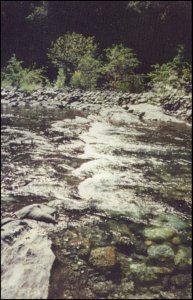 For me, building the equipment, and showing others how and where to use it, widened the pleasures found in our gold mining adventures. Since then, some part of every prospecting trip has been devoted to showing at least one beginner how it all works.
For me, building the equipment, and showing others how and where to use it, widened the pleasures found in our gold mining adventures. Since then, some part of every prospecting trip has been devoted to showing at least one beginner how it all works.
A case in point happened over our last three sniping trips to the Mother Lode. Sniping has two related meanings in a mining sense. To the old-timer, sniping meant using light, portable equipment to work the high-grade deposits along the banks of gold-bearing streams and rivers. These banks were sampled quickly. When a suitably-rich deposit was found, it was worked as fast as possible and the miner was off to the next spot.
Today, sniping also means working gold-bearing waters with a mask and snorkel and a few hand tools. Higher-grade spots are still worked quickly and the miner is off to the next hot spot. The equipment must be light, because the sniper usually has to cover a large area.
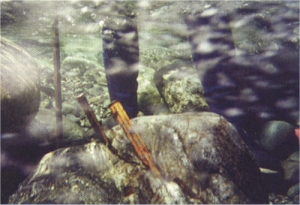 Over the years, I have gravitated to this type of mining. There is nothing quite like the thrill of spotting gold sitting on the exposed bedrock, right there for the picking. This is where my love of sniping, joy in teaching, and my friend Howie all came together.
Over the years, I have gravitated to this type of mining. There is nothing quite like the thrill of spotting gold sitting on the exposed bedrock, right there for the picking. This is where my love of sniping, joy in teaching, and my friend Howie all came together.
We first met Howie at the Mineral Bar Campground on the North Fork of the American River. We pulled into our camp spot and within an hour there was Howie, the itinerant camp-greeter. He was living out of his old Dodge van and finding a little gold with his gold pan.
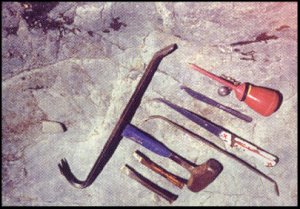 Over the next few days, Howie watched me don my wetsuit and head up the river. In the evening, he would watch me clean up the gold. On the third evening, I asked if he would like to try his hand at sniping. I would supply the tools and a day’s instruction. As it turned out, we worked together for about four days. In that time, Howie learned to look for bedrock cracks, but not just any cracks. We wanted cracks that were fed by other features surrounding them. Low spots and shallow channels were examined for cracks. Areas downstream from large obstructions, like trees and boulders, were worked. Any patch of broken or rough bedrock was investigated. We hand-fanned away shallow overburden, looking for hidden gold-bearing spots. There were a lot of places to look!
Over the next few days, Howie watched me don my wetsuit and head up the river. In the evening, he would watch me clean up the gold. On the third evening, I asked if he would like to try his hand at sniping. I would supply the tools and a day’s instruction. As it turned out, we worked together for about four days. In that time, Howie learned to look for bedrock cracks, but not just any cracks. We wanted cracks that were fed by other features surrounding them. Low spots and shallow channels were examined for cracks. Areas downstream from large obstructions, like trees and boulders, were worked. Any patch of broken or rough bedrock was investigated. We hand-fanned away shallow overburden, looking for hidden gold-bearing spots. There were a lot of places to look!
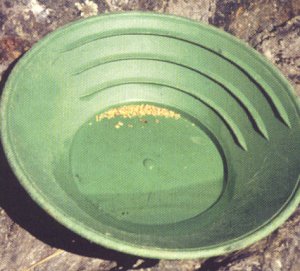 We found lots of flake-gold and a few small gold nuggets by splitting small cracks with my four-pound hammer and a one-inch chisel. We cleaned other spots with small hook tools. At times, we just picked the flakes off the bedrock with our fingers.
We found lots of flake-gold and a few small gold nuggets by splitting small cracks with my four-pound hammer and a one-inch chisel. We cleaned other spots with small hook tools. At times, we just picked the flakes off the bedrock with our fingers.
By the end of the fourth day, Howie had the basics down, but he was still leaving a lot of gold in the spots he worked. The best I could do was to tell him to be more thorough in the areas that showed good potential. Those tiny cracks can hold as much gold as the larger, easier ones do; and there are a lot more of them.
One year later, we met again. Howie’s old van was now a truck, but camping still was home. We worked together for a few days, and I did see progress. He was finding better spots and working them more diligently, but he was still leaving some easy gold for me to find when I checked his spots.
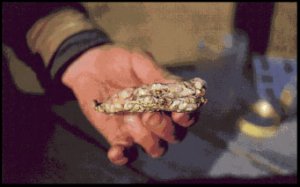 That was last year. This year, Howie is an accomplished sniper. A few hours spent together in the water proved that. Somehow, between this year and last, Howie got thorough. At an evening get-together, Howie turned to me and quietly said “I really have gotten better at sniping.” I already knew that. The gold in his bottle said a lot.
That was last year. This year, Howie is an accomplished sniper. A few hours spent together in the water proved that. Somehow, between this year and last, Howie got thorough. At an evening get-together, Howie turned to me and quietly said “I really have gotten better at sniping.” I already knew that. The gold in his bottle said a lot.
If this type of mining seems appealing, don’t just sit on a boulder with a fishing rod in one hand and a pan in the other. Find yourself an old wetsuit, mask, snorkel, crack hammer, a few crack hooks, and jump in. As soon as you uncover your own first piece of gold, you will know how I feel about sniping.
If you find me out mining on the river, I will always have a little time to talk. See you out there!


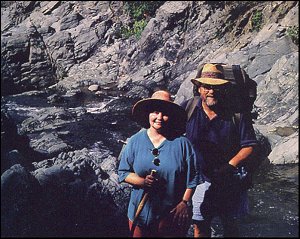 As young kids growing up in the country, we would play a joke on the new kids from the city. We would take them “snipe hunting”, or “sniping.” You see, sniping is a way of catching a small, but very tasty bird.
As young kids growing up in the country, we would play a joke on the new kids from the city. We would take them “snipe hunting”, or “sniping.” You see, sniping is a way of catching a small, but very tasty bird.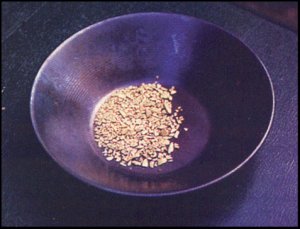
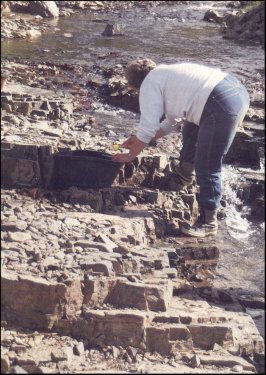 With each scoop of dirt and piece of bedrock I dumped into the bucket, it was tempting to glance over my glasses to try and catch a glimpse of
With each scoop of dirt and piece of bedrock I dumped into the bucket, it was tempting to glance over my glasses to try and catch a glimpse of 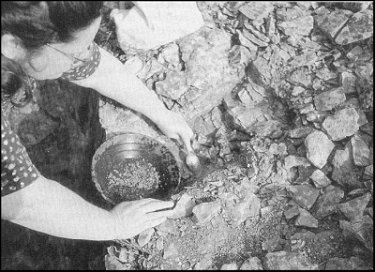 If it is convenient, sometimes I am able to drive my pickup truck close to the golden spot that I have chosen. I carry a five-gallon jug of water, a small plastic tub big enough to pan into, and a few tools for crevicing. Without having to walk down to a stream, I can pan-out my pay-dirt into the tub with water from my five-gallon jug. This makes working bedrock a lot easier.
If it is convenient, sometimes I am able to drive my pickup truck close to the golden spot that I have chosen. I carry a five-gallon jug of water, a small plastic tub big enough to pan into, and a few tools for crevicing. Without having to walk down to a stream, I can pan-out my pay-dirt into the tub with water from my five-gallon jug. This makes working bedrock a lot easier.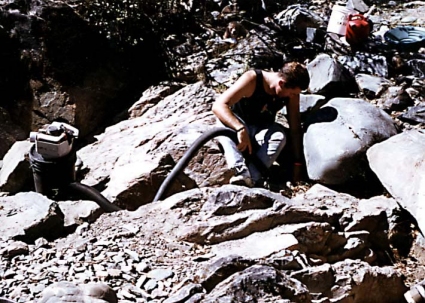
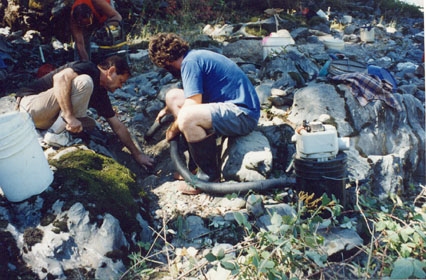
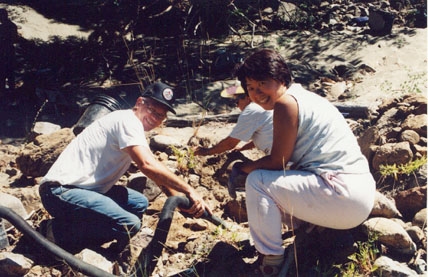
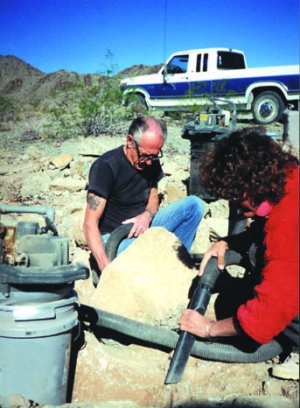 This is a picture that you will seldom see – me getting up at 5:30 a.m. full of excitement – to vacuum! Yet, I spent some of last summer and almost all of this past winter, doing just that. It wasn’t “dust bunnies” I was after, however; it was
This is a picture that you will seldom see – me getting up at 5:30 a.m. full of excitement – to vacuum! Yet, I spent some of last summer and almost all of this past winter, doing just that. It wasn’t “dust bunnies” I was after, however; it was 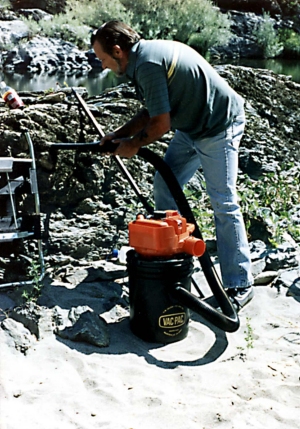 Finding new places to vack was not easy, as I have said. I have known for years, from experience, that the gold in the deserts isn’t always where it is supposed to be. What would look like great bedrock on the rivers often means nothing in the desert, mostly due to the lack of water volume and movement in the deserts. When I arrived at Quartzsite I met up with Al Powell, who is also a
Finding new places to vack was not easy, as I have said. I have known for years, from experience, that the gold in the deserts isn’t always where it is supposed to be. What would look like great bedrock on the rivers often means nothing in the desert, mostly due to the lack of water volume and movement in the deserts. When I arrived at Quartzsite I met up with Al Powell, who is also a 
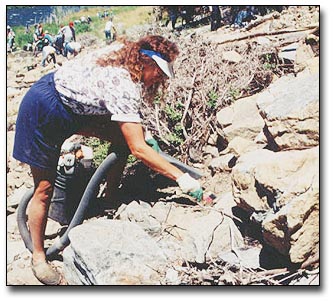 suckers
suckers



